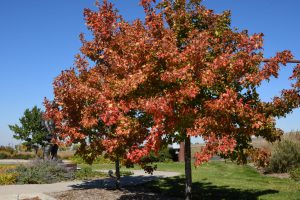Fall in Colorado – Setting Your Yard Up for Success
Fall In Colorado
Colorado weather is ever changing, fluctuating from record-breaking heat in the summer to an early snowstorm in September, followed by a dry fall, and a late October cold snap. Climate experts are pointing to more dry weather through January due to emerging La Nina weather patterns. Your yard and gardens can benefit from a little help from you to make it through the winter.
Here are some tips on getting your perennial garden, trees and sprinkler system ready for winter and the next growing season.
- Insulate the soil. A good way to keep your tree roots and perennial garden warm during the fall and winter in Colorado is to add a base layer of about 4 to 6 inches of mulch. Mulch will keep the warmth and moisture in the ground. If you do not want to buy mulch, you can use the leaves from your trees.
- Wrap your tree trunks. To prevent bark damage, wrap the trunks of younger trees up to the first branches using commercial tree wrap. Leave the wrap on until early April. Younger trees are susceptible to sunscald and frost cracks because of drastic winter temperature fluctuations. Make sure to use a white commercial tree wrap or plastic tree guards. For more information on how to protect you trees during the winter visit Front Range Arborists’ blog on winter care for trees.
- Winter Watering. Make sure to give your perennial garden and trees a big drink before putting your hoses away for the season. It may help your if you start to wean your plants and trees of water before the first frost hits. Your perennials and trees do need water during winter months especially if there is no precipitation. Water at least once a month only when air temperatures are above 40 degrees F. Apply water during the warmest part of the day so the ground has time to soak up the water and doesn’t freeze overnight. For more information visit Colorado State University Extension’s Fall and Winter Watering Guide.
- Turn off underground sprinkler system. It is always best to have your system winterized by the first freeze, but sometimes that comes before the season is over. If this happens, make sure your irrigation clock is turned off and you insulate your backflow preventer. Once the irrigation season is over, make sure to walk around your yard to check for leaks in the sprinkler zones and valve box. Not the Do – It – Yourself type? Hire an expert that you trust or that has been referred to you. For more information please visit Colorado State University Extension’s Home Sprinkler Guide.
Also, check out our Saving Outdoors page for watering updates and drought information.
Photos Credited By: Heather Waters at Fire Station #5
Recommended Posts








